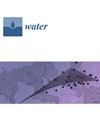Research on Water Content Spatial Distribution Pattern of Fine—Grained Sediments in Debris Flow—Taking Beichuan Debris Flow as a Case
IF 3
3区 环境科学与生态学
Q2 ENVIRONMENTAL SCIENCES
引用次数: 0
Abstract
Due to being lightweight, fine-grained sediments easily flow with water and thus amplify the destructive effect of debris flow hazards. In such hazards, water content and shear strength are key inter-controlled factors relating to the stability of fine-grained sediments and thus control the density, scale, and danger of debris flow hazards. Although the correlation between water content and sediment stability has been studied, there are still some issues to be solved: what is the changing trend of shear strength with increasing water content? What is the water content spatial distribution pattern of fine-grained sediments in debris flow? What is the role/impact of this pattern on debris flow hazards prevention? Therefore, the objective of this research is to show the spatial distribution pattern of water content and establish a correlation between the water content and the shear strength of fine-grained sediments to provide a scientific basis for debris flow hazard prevention. Taking the Beichuan debris flow for our study, with a length of 37.6 km, and a 341 km2 study area, the results show that (1) the average water content shows an increasing trend, from 9.9% in the upstream of the river (SP01–SP05) to 21.7% in the downstream of the river (SP13–SP15). (2) When unsaturated, the correlation between the water content and shear strength is determined by combining the cohesion, normal stress, and internal friction angle; when saturated, the water content is negatively correlated with shear strength. (3) Water content and shear strength are the key inter-controlled factors relating to the stability of fine-grained sediments, and the water content distribution pattern of this research indicates the key locations that require attention: locations with high water content in the downstream river or with high curvature, which is of some significance for debris flow hazard prevention.泥石流中细粒沉积物含水率空间分布格局研究--以北川泥石流为例
由于重量轻,细粒沉积物很容易随水流动,从而扩大了泥石流灾害的破坏力。在此类灾害中,含水量和剪切强度是与细粒沉积物稳定性相关的关键互控因素,从而控制着泥石流灾害的密度、规模和危险性。虽然含水率与沉积物稳定性之间的相关性已得到研究,但仍有一些问题有待解决:随着含水率的增加,剪切强度的变化趋势如何?泥石流中细粒沉积物的含水率空间分布模式是怎样的?这种格局对泥石流灾害预防的作用/影响是什么?因此,本研究的目的是揭示含水率的空间分布规律,并建立细粒沉积物含水率与剪切强度之间的相关性,为泥石流灾害防治提供科学依据。以北川泥石流为研究对象,全长 37.6 km,研究面积 341 km2,结果表明:(1)平均含水率呈上升趋势,从河流上游(SP01-SP05)的 9.9%上升到河流下游(SP13-SP15)的 21.7%。(2)非饱和时,含水量与剪切强度的相关性由内聚力、法向应力和内摩擦角共同决定;饱和时,含水量与剪切强度呈负相关。(3)含水率和抗剪强度是细粒沉积物稳定性的关键互控因素,本研究的含水率分布模式指出了需要关注的关键位置:下游河道含水率高或弯曲度高的位置,这对泥石流危害的预防具有一定意义。
本文章由计算机程序翻译,如有差异,请以英文原文为准。
求助全文
约1分钟内获得全文
求助全文
来源期刊

Water
WATER RESOURCES-
CiteScore
5.80
自引率
14.70%
发文量
3491
审稿时长
19.85 days
期刊介绍:
Water (ISSN 2073-4441) is an international and cross-disciplinary scholarly journal covering all aspects of water including water science and technology, and the hydrology, ecology and management of water resources. It publishes regular research papers, critical reviews and short communications, and there is no restriction on the length of the papers. Our aim is to encourage scientists to publish their experimental and theoretical research in as much detail as possible. Full experimental and/or methodical details must be provided for research articles. Computed data or files regarding the full details of the experimental procedure, if unable to be published in a normal way, can be deposited as supplementary material.
 求助内容:
求助内容: 应助结果提醒方式:
应助结果提醒方式:


